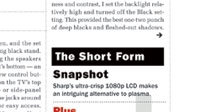Anatomy of an HDTV Test Report Page 2
 SETUP The next section, Setup, is where we cover the nuts and bolts of getting the TV to look its best. This often starts with a discussion of appropriate seating distance for the set's screen size and resolution, as well as any screen-glare issues - a factor with some plasma and rear-projection models - that might affect placement. But the primary focus of this section is an overview of video adjustments that the set supplies for tweaking pictures.
SETUP The next section, Setup, is where we cover the nuts and bolts of getting the TV to look its best. This often starts with a discussion of appropriate seating distance for the set's screen size and resolution, as well as any screen-glare issues - a factor with some plasma and rear-projection models - that might affect placement. But the primary focus of this section is an overview of video adjustments that the set supplies for tweaking pictures.
Most TVs provide a number of picture presets to automatically change the brightness, contrast, color balance, and, in some cases, sharpness of images. They also have presets that alter the picture's color for a cool (blue) balance or a warm (red) one. To show pictures with accurate color, TVs need to display images across the entire Grayscale - the range of gray steps between black and white - at a color temperature of 6,500 kelvins (K), which is a unit of measurement based on a theoretical "black body" heated to a specific temperature. This 6,500-K specification, roughly equivalent to the look of sunlight on a clear summer day, applies equally to both regular analog and high-definition digital TV.
Few TVs can hit the 6,500-K spec using out-of-the-box adjustments, but our Setup section identifies which combination of presets can bring you close to getting an accurate range of grayscale steps. We also indicate how flexible the set is in saving any custom picture adjustments you make and whether or not these can be stored independently for each video input. TVs from different makers often come with their own unique set of advanced picture adjustments. We call out the ones that are useful for getting good image quality, and we also indicate if any service-menu adjustments - a set of tweaks that aren't normally accessible to users but can be made by a certified technician - were required to get the TV up to snuff for the Performance section of our evaluation.




























































